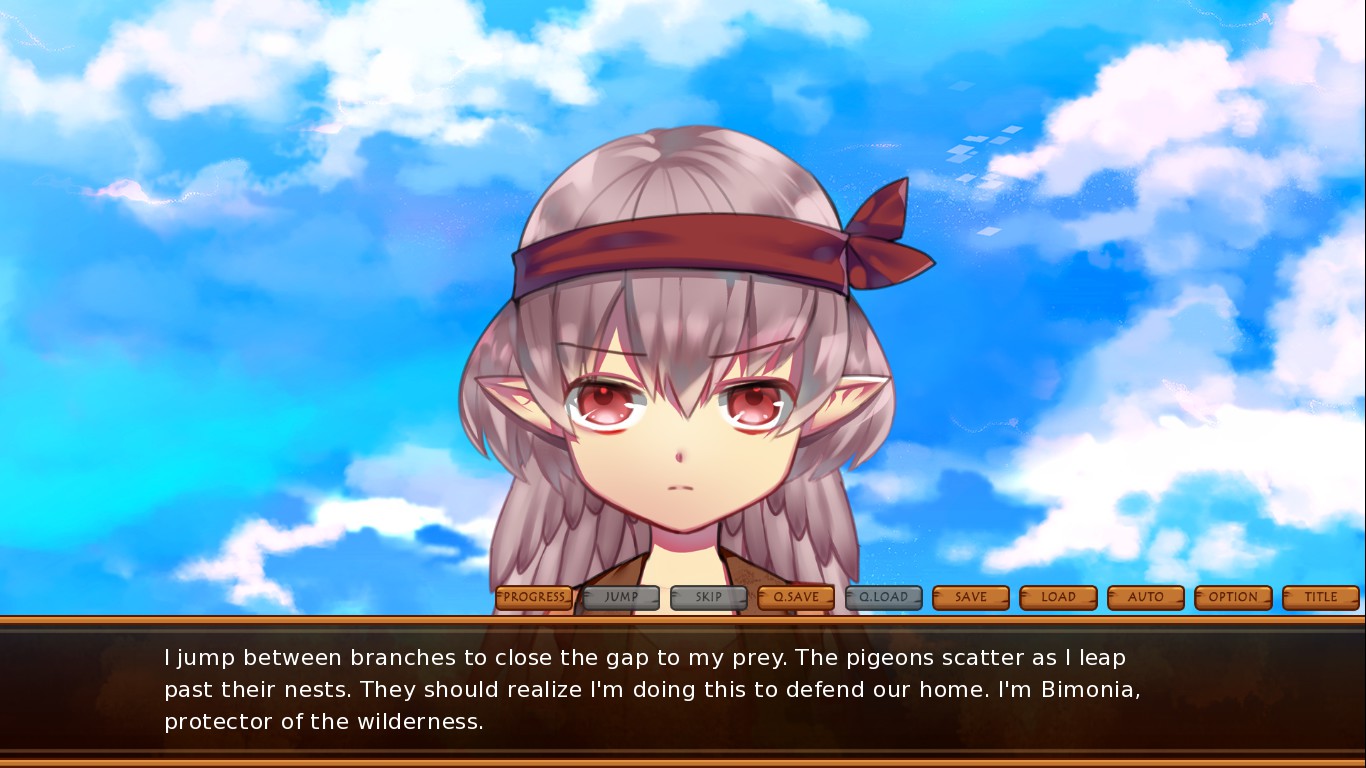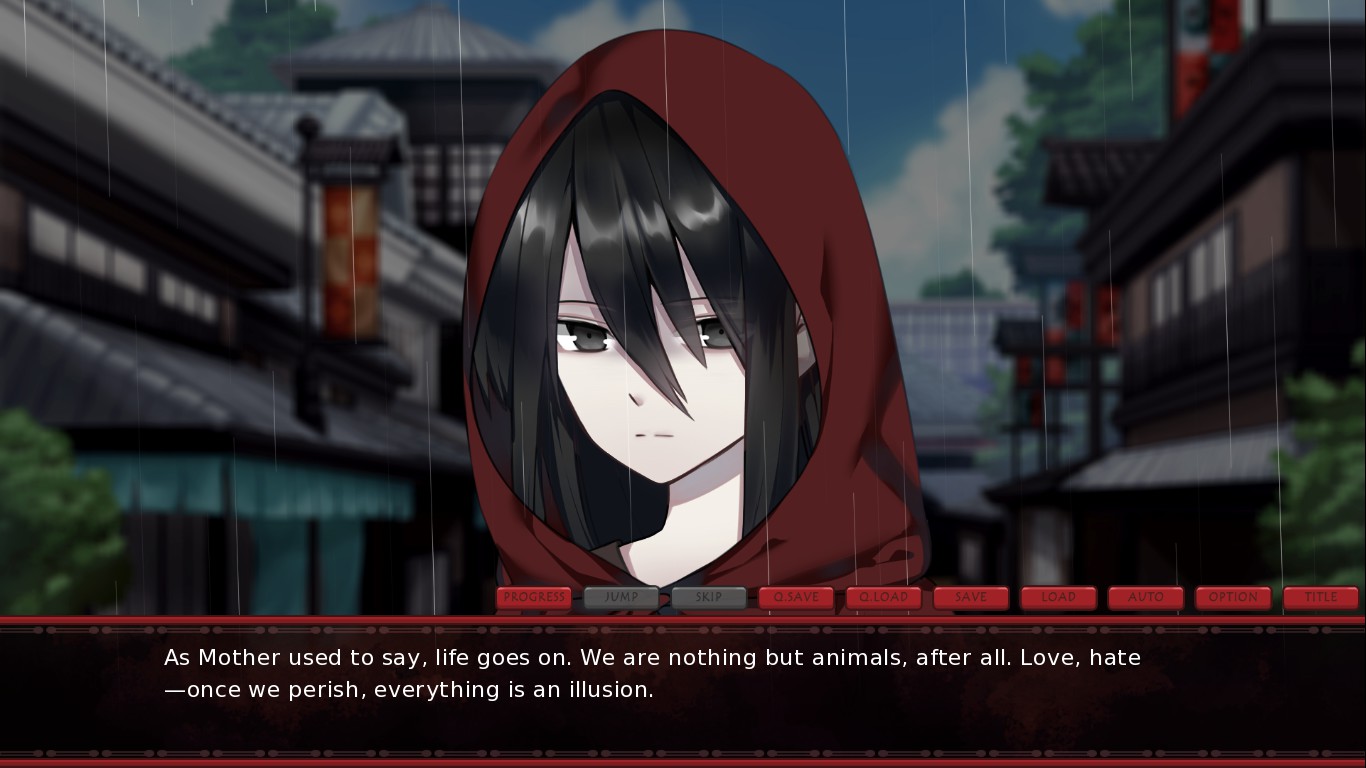Review | The Last Birdling
Developer InvertMouse has come out with a constant stream of visual novels since 2012, so it’s no surprise that that streak has continued. Their latest work, The Last Birdling, tells a tale of friendship and heartbreak through the eyes of two main characters, boasting dual perspectives alongside multiple endings.
As a visual novel, its mechanics are simple — skipping from one piece of text to the next is as easy as clicking anywhere on the screen. Text itself is displayed in a clear font along the bottom, with a menu bar resting on top of it. This bar seems a bit cluttered because of both quick and normal save and load options which are probably more redundant than useful, but at least they’re easy to access, rather than hidden in a secondary menu.
You can progress at your own speed or click the ‘auto’ button, which is a tad more relaxed than clicking all the time and progresses through the story for you. The speed of this is adjustable in the options, although it’s worth sticking with clicking if you’re a fast reader, since the sliders only go so far. Unfortunately if you get distracted whilst on auto, there’s no ‘previous’ button to rectify that; this is more an issue when returning from one of the menu screens while on auto, which skips straight to the next line of text.

The story begins with Bimonia, a young birdling still learning the ways of her kind, coming upon a human in the forest. This is Tayo, who lives in the nearby village under the strict care of her mother. From there on, you get to play as each in turn, immersing yourself in the world of two young girls struggling to maintain a friendship against a history of war. When you eventually get into the characters’ minds and come to terms with some alarming mood swings, you can often empathise with them and find yourself touched by the adorable moments they share together.
Just as this is a story about those two girls, it also happens to be about their mothers. The actions both girls take impact not only on their own relationship, but their home lives too. It’s up to you to decide if you want to hold on to family ties or undermine them in the name of friendship.
If you’ve just read the above and think that this will be a light-hearted, feel-good tale, think again. While some moments can evoke those feelings, a good portion of the story is dark, grim and brutal. From Tayo’s borderline psychopathy and frequent fatalism to the dismemberment and defilement of other characters, it becomes clear that this is not a game for children.
That said, only one very short scene strays toward being tactless — the scene’s existence makes sense and its shock value is warranted, but its description comes across a little crude. The story content would, in an ideal world, warrant a brief ‘this contains content of a certain nature’ warning in the Steam description or trailers, but with any hope this will be included before release and tagged by users afterward.

The Last Birdling, as with many in its genre, gets off to a slow start. The first two hours of story (the first half, in fact) felt bloated, although not to the same extent as visual novels spanning hundreds of hours. This may in part be due to the fact that there is not a lot of dialogue in the story, with the majority of text being character thought and perspective. The main issue is repetition: a little bit is good to get sentiments across, but there comes a point where characters repeating similar thoughts, reminiscing or travelling becomes extraneous. If the first half were reduced to an hour’s play-time rather than two, it would retain its meaning while heightening its impact on the reader and seem less like monologuing talking heads.
You will be rewarded if you put up with the first half, though, as the pace picks up and the stakes become more important. The plot delivers some emotional blows, sets up characters with well-hidden motives and dishes out surprise with the most unexpected and dramatic of twists. And, when it comes to the end, it touches on the perfect amount of bittersweet satisfaction in each version. However, the author has stated that one ending features the same final twist as a previous game, which doesn’t seem like something they should admit to as it cheapens the uniqueness of the surprise somewhat.
To get each of these endings requires a certain combination of choices throughout the story. There are twenty-one in total, but it feels like fewer because of the amount of time that passes between them. Each has two options — one which awards what we’ll call a ‘friendship point’ to the character you’re not currently playing and one which does nothing. The different endings trigger based on the number of friendship points each character has by the end and you can keep easy track of this using the progress button, which shows both how many endings you’ve unlocked and how many points you have.

There are five endings to unlock, in total, and each feels as fitting as the other. As advertised, this is the only point in the story at which it branches. Although some text within the story changes depending on choices you’ve made, nothing affects the path you take through the tale. You’ll be pleased to know that you don’t have to sit through the entire opening again to unlock them, as finishing the game once unlocks the jump and skip options. Jump skips straight to the next choice, while skip fast-forwards to either the next choice or any text which has changes as a consequence of choice. In general, the choices are good, but you may feel the need for a third option and the immediate consequences sometimes don’t make sense, or seem overblown.
But surely you’d be happy to read through the story again? Well, if you ignore the bloated first half and the limited variation from choices early-on, you’re still faced with one stumbling block: the writing. It isn’t unreadable, but it certainly would have benefitted from proof-reading. The most common mistake is getting tenses mixed up, which can be quite jarring to read. Thoughts aren’t separated from description, either, so the characters can seem a bit jumbled in their speech where the use of italics or similar would have rectified this. These and a few other small mistakes give the overall impression of a lacklustre translation, which feels a shame to say considering the obvious amount of effort that went into producing a story of this length.

Most of the story is illustrated through the facial expressions of character portraits against a detailed location backdrop. Some important scenes are drawn in their beautiful entirety, but a side effect of the story’s length is that these illustrations seem few and far between. The vast majority of the story is accompanied by talking heads (that seem out-of-place in a story written in first person), which is understandable, but it would be nice to see the characters in a few different poses throughout the story for variety. As it is, there isn’t much to hold your attention at the top of the screen.
The soundtrack is good and stands out on its own as something easy to listen to outside the game, but as with everything else it suffers from the story’s length, making it feel a bit repetitive by the end. The more dramatic and sad pieces do a great job highlighting the important moments, though.
There are a few extra items to look at as well, with a glossary and gallery included on the title screen. Links to glossary entries flash up on the screen every now and then as you’re playing, but you can read them all before you begin anyway — it perhaps may have been more fun to unlock them as you play along, but it is an interesting addition and insight into the world of birdlings.
When the game releases in September, you will also be able to buy the artbook. Most of the art in it is also in the gallery, but here they are accompanied by comments from the author and some concept art (which is sadly relegated to the final pages). And of course, there are obligatory trading cards and achievements.
The Last Birdling is a mixed bag. It’s likely you’ll enjoy it if you’re a fan of many other games in the genre, but newcomers and sceptics might be put off by poor grammar and a first half that drags. The final twists of the story are a treat, but outside skipping through the choices again to unlock every ending, it isn’t something that lends itself to being read through in its entirety a second time.
Comments are closed.